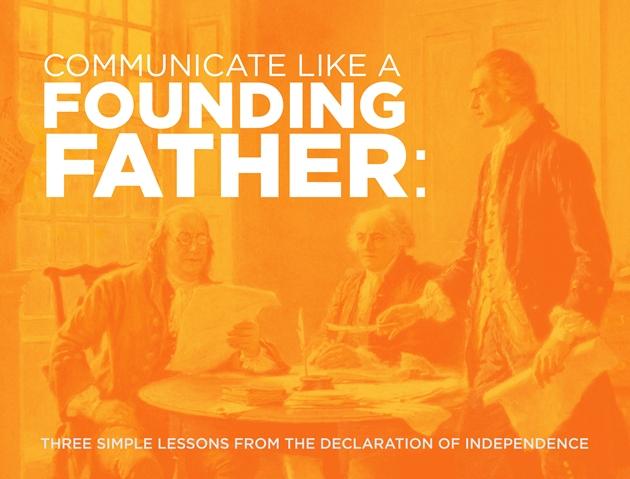When in the course of human events it becomes necessary to write a guest article for my good friends at MarketingProfs, I figured the patriotic approach would be the right one in honor of America's big 2-3-9: I thought I'd pay homage to one of the most well known and effective pieces of content ever drafted—one written with quill and ink rather than on a MacBook keyboard.
That's right, the Declaration of Independence, a timeless document that reached millions and quite literally changed the world. No viral videos, no hashtags, no email, tweets or shares: simply some of the most powerful and beautifully composed words ever recorded.
And believe it or not, the Declaration of Independence follows a simple formula dating back thousands of years to one of the original thought leaders about the art of persuasion, Aristotle, who called it Ethos, Pathos, and Logos.
Today we've adapted this method as Know, Feel, and Do (KFD).
Despite how incredibly simple this approach may seem, too many people get it wrong. They think this method doesn't apply to them or their industry, and they leave crucial elements on the chopping block.
So I thought I'd take it upon myself to show how one of the most powerful and revolutionary pieces of communication ever written follows the KFD framework.

1. Know
What are the nuts and bolts of Thomas Jefferson's words?
- The nature of the message itself has become a necessity.
- All men are created equal.
- All men are endowed with certain unalienable rights: Life, Liberty, and the Pursuit of Happiness.
- When a government becomes destructive of these rights, it is the right of the people to abolish it and institute a new Government.
- King George III of Britain is guilty of such violations.
- (Every violation is laid out in detail.)
These are the most obvious pieces information that can be extracted from the document. In Jefferson's own words: "To prove this, let Facts be submitted to a candid world."
In the business world, this is the easy stuff—the details any employee can rattle off without so much as a thought. Your value prop. Your product or service offering. The year you were founded. Even things like revenue, cash flow, and other financial data. The easy stuff.
The problem is, too many people not only lead with the Know but also rely on it for the bulk of their message. Big mistake. It's simply incomplete.
After a closer look at the Declaration, we can begin to see the more subtle elements of the text that still makes it such a compelling message.
2. Feel
What are the more evocative elements of the Declaration? What sort of emotional response is the document aiming to create? The answer depends on which audience you're talking about.
In King George and others in England, it was intended to create a combination of fear, respect, and intelligent, calculated defiance. The United States wanted Britain to feel they were a force to be reckoned with. That their quest for revolution was not a cause taken on by a few but reflected the fervor of a united people. They wanted Britain to feel afraid of what the United States was capable of and what lengths they would go to win their freedom.
Passages such as "a decent respect to the opinions of mankind requires that they should declare the causes which impel them to the separation" create a sense of justice and righteousness on behalf of the Colonies that galvanized and united people together.
Another passage reads, "Our repeated Petitions have been answered only by repeated injury." Again, although inherently directed at Britain and King George, the Declaration effectively became a Declaration of Unity and shared injury by the United States as much as it was a Declaration of Independence.
The carefully crafted language touches what are emotional pressure points in most normal human beings. On purpose.
The Feel is the thing often completely missing in the ways so many companies and leaders communicate. They'll disregard emotional appeals as "fluff" or unneeded "soft stuff." But that's simply thinking about it in the wrong way: It's not about distracting your audience from the core of your message, it's about using the type of language and focused human approach to telling your story that can cue an emotional response.
Use metaphors, stories, and relatable concepts that anyone can latch on to and engage with. Bring complex ideas out of the dirt and clean them up by using a parallel or analogy to help illustrate the idea you're making.
The human mind is a powder keg of imagination and emotion. Use them.
If it was important enough for Thomas Jefferson and the Founding Fathers, it's good enough for you.
3. Do
The third variable in the KFD formula prompts the question: So what's the point?
Any piece of persuasive communication, whether a sales presentation or a timeless nation-defining piece of historical writing, must make it abundantly clear what the audience is being implored to do upon hearing the message.
That's not to say it must be laser-focused specific. Though it could be: Your "ask," so to speak, in a product pitch might be " pull out your iPhone right now, tweet using this hashtag to get this promo code, and buy your product." Or it can also be as general as "consider how you get to work every day and whether you're making the most of your time."
The Do can be on either side of the spectrum—it just has to be there.
In the Declaration of Independence, the primary Do is the most obvious: Britain should heed to the terms of the document and grant the United States their independence.
The final paragraph reads, in part, "We, therefore, the Representatives of the united States of America... solemnly publish and declare, That these United Colonies are, and of Right ought to be Free and Independent States."
It's spelled out loud and clear; nothing is left to interpretation.
Does your marketing messaging do the same? The Do applies to more than just sales presentations or investor pitches. Everything from your website to both inbound and direct marketing campaigns should follow this rule.
Every message you send out to the world should make it very clear what the person on the other end of that message should do. Visit your website? Follow you on social media? Consider something about their own life? Pick up the phone and call you right this second as if their life depends on it?
Well, which is it? Make sure it's clear. You want your audience to strike the iron while it's hot, revolution or not.




